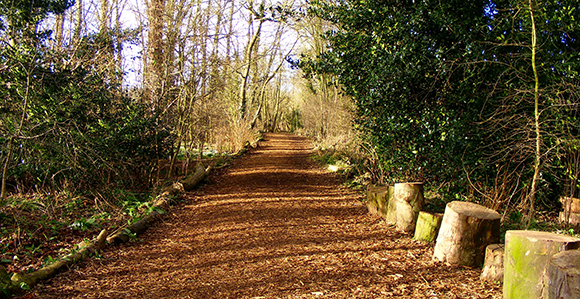Viewpoint: Walk the Covenant Path
Contributed By the Church News

We are all walking the covenant path back to Heavenly Father.
Article Highlights
- When you enter the waters of baptism and make covenants in the Lord’s temple, you are walking a path that will lead you back to Heavenly Father.
- We show our love for God by making and keeping covenants.
- We are all walking this path together.
“From the day of baptism through the spiritual milestones of our lives, we make promises with God and He makes promises with us. He always keeps His promises offered through His authorized servants, but it is the crucial test of our lives to see if we will make and keep our covenants with Him.” —President Henry B. Eyring
Related Links
During a 2010 trip to New Delhi, India, Sister Rosemary M. Wixom, Primary general president, walked a long path leading through Munirka, a three-block area that is a maze of dwellings inhabited by 400,000 to 500,000 people.
As she walked deeper into the area, led by a guide, she passed homes and shops.
And although it was crowded, she wasn’t frightened. She felt a “spirit of humanity, of love and respect.”
“I sensed as I walked that path, we were all on the same path together,” she said. “We were all on the path to Heavenly Father, as diverse as we are” (Church News interview, 2010).
In the years since that experience in New Delhi, Sister Wixom has often referred to that path as “a covenant path.”
A covenant is “a sacred agreement between God and a person or group of people,” according to ChurchofJesusChrist.org. “God sets specific conditions and He promises to bless us as we obey those conditions.”
Latter-day Saints who enter the waters of baptism and make covenants in the Lord’s temple are walking a path that will lead them back to God.
Presiding Bishop Gary E. Stevenson said during his April 2014 general conference address that in our lives certain things are absolutely essential. “These spiritual markers are the essential God-given ordinances of the gospel,” he explained (“Your Four Minutes”).
When we realize that we are children of the covenant, we know who we are and what God expects of us, said Elder Russell M. Nelson of the Quorum of the Twelve Apostles during his October 2011 general conference address.
“Children of the covenant have the right to receive His doctrine and to know the plan of salvation. They claim it by making covenants of sacred significance. … They keep the covenant by obedience to His commandments” (“Covenants”).
Individuals come to know who they are as they live their covenants and follow the path of the Lord, Sister Wixom said during a campus devotional held in the Marriott Center at Brigham Young University on March 12, 2013.
“We are a making and keeping covenant people, and nothing better shapes us than the sacred covenants we make to the Lord,” she said during the devotional. “Living these covenants is when we follow His plan, and we come to know who we really are.”
Nephi, referring to the path back to our Father in Heaven, said, “O how great the plan of our God!” (2 Nephi 9:13).
President Henry B. Eyring, First Counselor in the First Presidency, called covenants “spiritual milestones.”
“The Latter-day Saints are a covenant people,” he said during his October 1996 general conference address. “From the day of baptism through the spiritual milestones of our lives, we make promises with God and He makes promises with us. He always keeps His promises offered through His authorized servants, but it is the crucial test of our lives to see if we will make and keep our covenants with Him.”
Sister Linda K. Burton, Relief Society general president, said during her 2013 general conference address that keeping covenants is essential for true happiness.
“May we go forth with faith, cheerful hearts, and a great desire to be covenant keepers,” she said. “This is how we demonstrate our love for our Father in Heaven and our Savior.”
President Thomas S. Monson said as members of the Church we should revere our covenants. “Yes, I speak of the covenant of baptism, the covenant of the priesthood, and the covenant of marriage as examples,” he said during a March 7, 1993, CES devotional address. “Faithfulness to them is a requirement for happiness.”
That is because the covenants we make with the associated ordinances we receive in the temple become our credentials for admission into God’s presence, said Sister Silvia H. Allred, then a member of the Relief Society general presidency, during her October 2008 general Relief Society Meeting address. “These covenants elevate us beyond the limits of our own power and perspective. We make covenants to show our devotion to build up the kingdom. We become covenant people as we are placed under covenant to God. All the promised blessings are ours through our faithfulness to these covenants” (“Holy Temples, Sacred Covenants”).
That’s what Sister Wixom found while navigating the path through Munirka in New Delhi, India.
There she visited in the homes of two Latter-day Saint families: Joseph and Shagaya Mary Sathyanathan and their boys, Solomon, 12, and Simon, 7; and Anil and Ritu Kumar and their children, Twinkle, 8, and Akash, 7.
For these families, prayer and scripture study and family home evening were “a way of life,” recalled Sister Wixom. “The gospel of Jesus Christ is not just a tentacle in their lives. It is their life. It is their focus. Sharing as a family their love for Jesus Christ is their focus.”
For Sister Wixom, being in their homes was like standing on sacred ground. Truly, she said, their homes were like temples.
“We are walking this path together,” Sister Wixom said. “We have different circumstances, but we are on the same path.”
It is the covenant path that leads back to our Heavenly Father.
